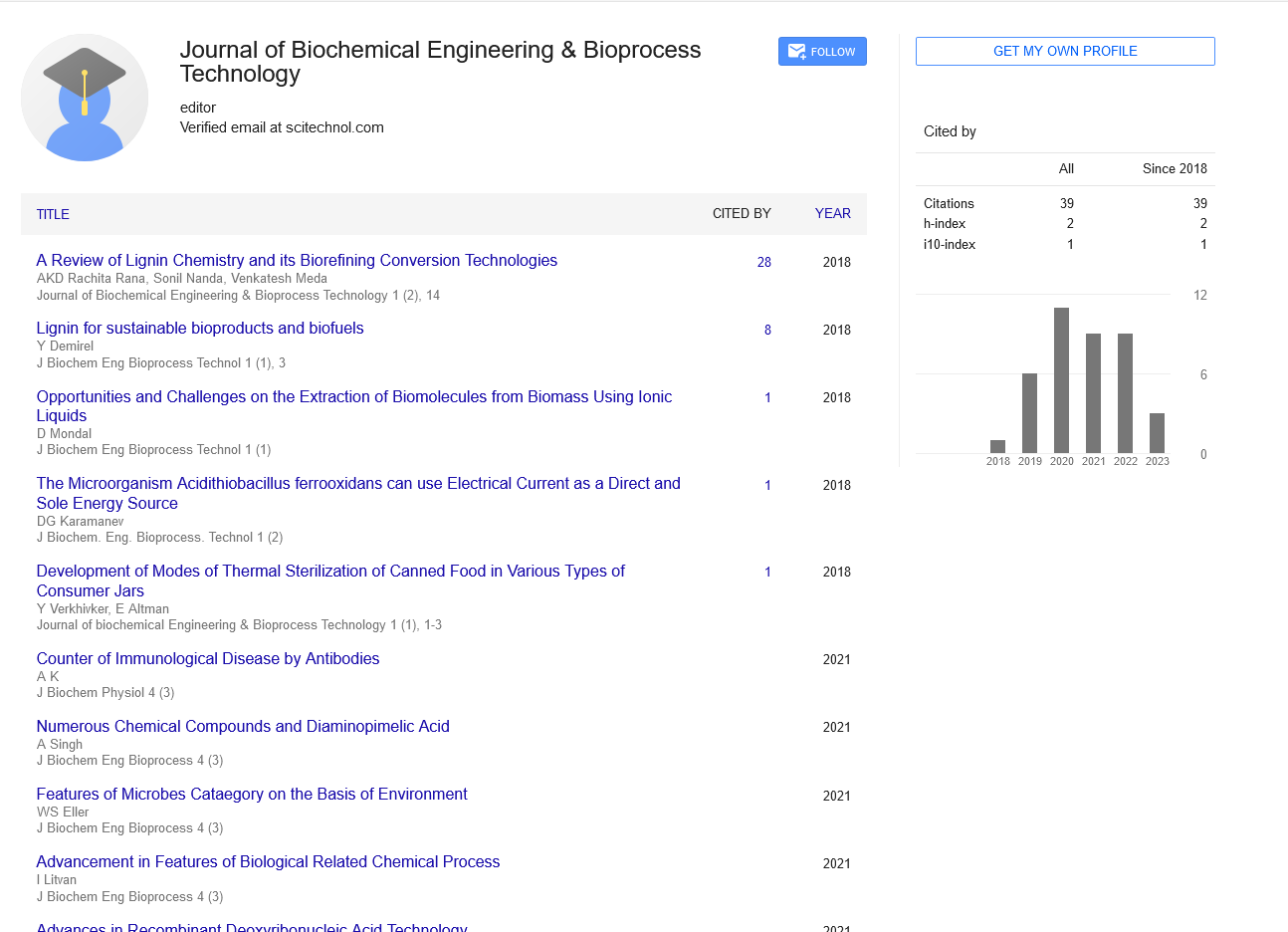Editorial, J Biochem Eng Bioprocess Vol: 4 Issue: 5
Standards of Science and the Apparatuses of Designing to Make Usable, Substantial, Monetarily Practical Items
Kiran Kumar M*
Department of Biotechnology, Ramaiah Institute of Technology Bengaluru, India
*Corresponding author: Kumar KM
Department of Biotechnology, Ramaiah Institute of Technology Bengaluru, India
E-mail: kkumarM@gmail.com
Received date: September 1, 2021; Accepted date: September 16, 2021; Published date: September 22, 2021
Abstract
Natural designing or bioengineering is the utilization of standards of science and the apparatuses of designing to make usable, substantial, monetarily practical items. Natural designing utilizes information and skill from various unadulterated and applied sciences, for example, mass and warmth move, energy, biocatalysts, biomechanics, bioinformatics, division and sanitization measures, bioreactor configuration, surface science, liquid mechanics, thermodynamics, and polymer science.
Keywords: Natural designing
Introduction
Natural designing or bioengineering is the utilization of standards of science and the apparatuses of designing to make usable, substantial, monetarily practical items. Natural designing utilizes information and skill from various unadulterated and applied sciences, for example, mass and warmth move, energy, biocatalysts, biomechanics, bioinformatics, division and sanitization measures, bioreactor configuration, surface science, liquid mechanics, thermodynamics, and polymer science. It is utilized in the plan of clinical gadgets, indicative gear, biocompatible materials, sustainable power, natural designing, rural designing, measure designing and catalysis, and different regions that work on the expectations for everyday comforts of social orders. Instances of bioengineering research incorporate microbes designed to create synthetic substances, new clinical imaging innovation, compact and quick infection analytic gadgets, prosthetics, biopharmaceuticals, and tissue-designed organs. Bioengineering covers significantly with biotechnology and the biomedical sciences in a manner practically equivalent to how different types of designing and innovation identify with different sciences, (for example, aeronautic design and other space innovation to energy and astronomy). As a rule, organic architects endeavor to either impersonate natural frameworks to make items, or to adjust and control organic frameworks. Working with specialists, clinicians, and scientists, bioengineers utilize conventional designing standards and methods to address organic cycles, including approaches to supplant, expand, support, or anticipate compound and mechanical cycles.
Natural designing is a science-put together discipline established with respect to the organic sciences similarly that synthetic designing, electrical designing, and mechanical designing can be founded on science, power and attraction, and traditional mechanics, separately. Prior to WWII, organic designing had started being perceived as a part of designing, and was another idea to individuals. Post-WWII, it became all the more quickly, and the expression "bioengineering" was authored by British researcher and telecaster Heinz Wolff in 1954 at the National Institute for Medical Research. Wolff graduated that year and turned into the overseer of the Division of Biological Engineering at the college. This was whenever Bioengineering originally was perceived as its own branch at a college. Electrical designing was the early focal point of this discipline, because of work with clinical gadgets and apparatus during this time. At the point when architects and life researchers began cooperating, they perceived that the designers didn't think enough with regards to the genuine science behind their work. To determine this issue, engineers who needed to get into natural designing gave more opportunity to concentrating on the cycles of science, brain research, and medication. All the more as of late, the term natural designing has been applied to natural alterations, for example, surface soil security, slant adjustment, conduit and shoreline insurance, windbreaks, vegetation obstructions including clamor hindrances and visual screens, and the biological improvement of a space. Since other designing disciplines additionally address living organic entities, the term natural designing can be applied all the more comprehensively to incorporate rural designing. The principal natural designing project in the United States was begun at University of California, San Diego in 1966. Later projects have been dispatched at MIT and Utah State University. Numerous old horticultural designing divisions in colleges over the world have remarked themselves as farming and organic designing or rural and biosystems designing. As indicated by Professor Doug Lauffenburger of MIT, natural designing has an expansive base which applies designing standards to a colossal scope of size and intricacies of frameworks, going from the atomic level (sub-atomic science, organic chemistry, microbial science, pharmacology, protein science, cytology, immunology, neurobiology and neuroscience) to cell and tissue-based frameworks (counting gadgets and sensors), to entire plainly visible living beings (plants, creatures), and even to biomes and biological systems.
 Spanish
Spanish  Chinese
Chinese  Russian
Russian  German
German  French
French  Japanese
Japanese  Portuguese
Portuguese  Hindi
Hindi 